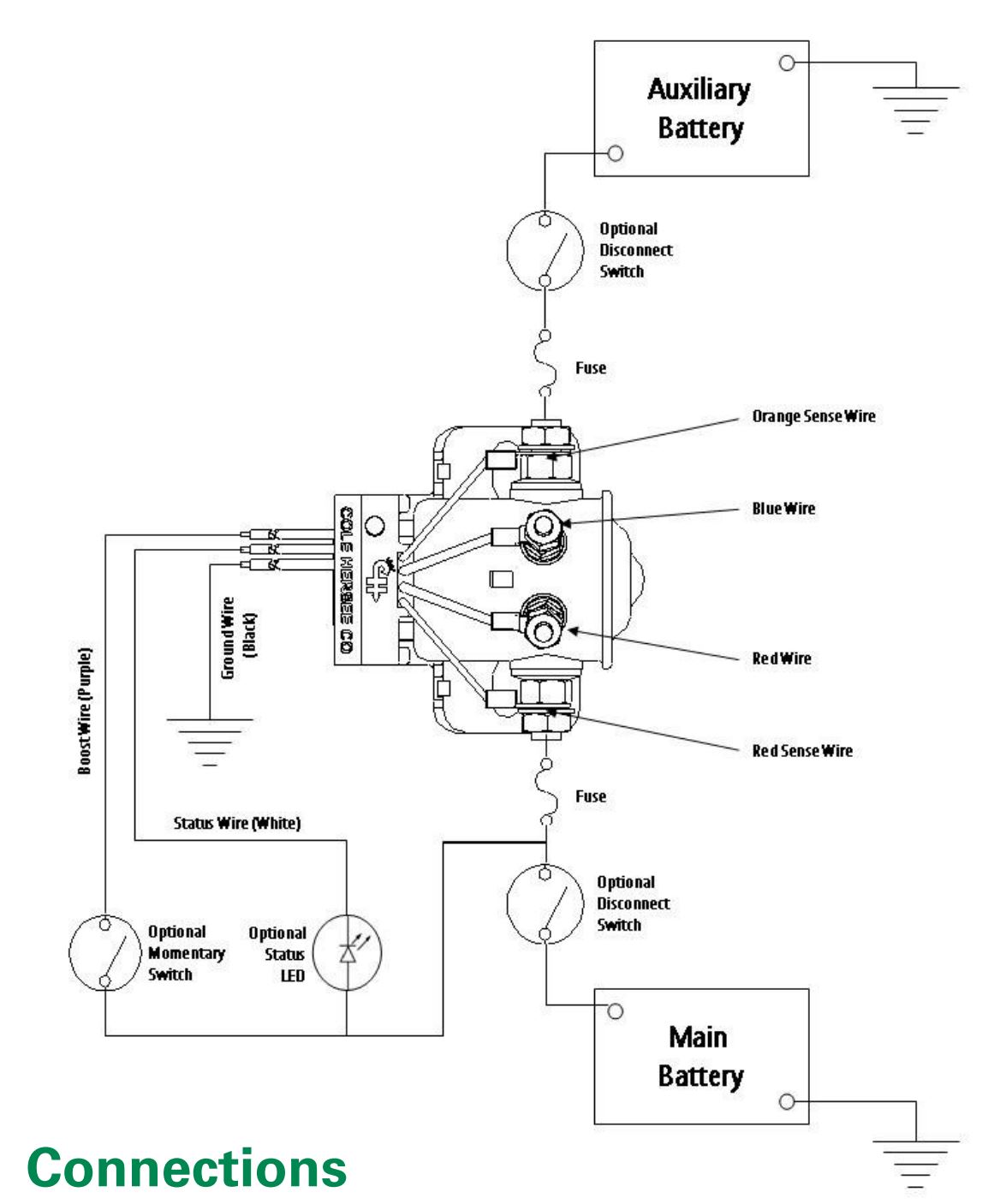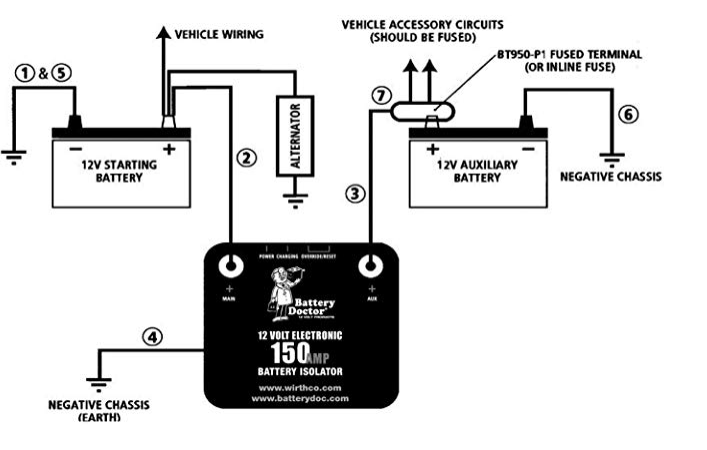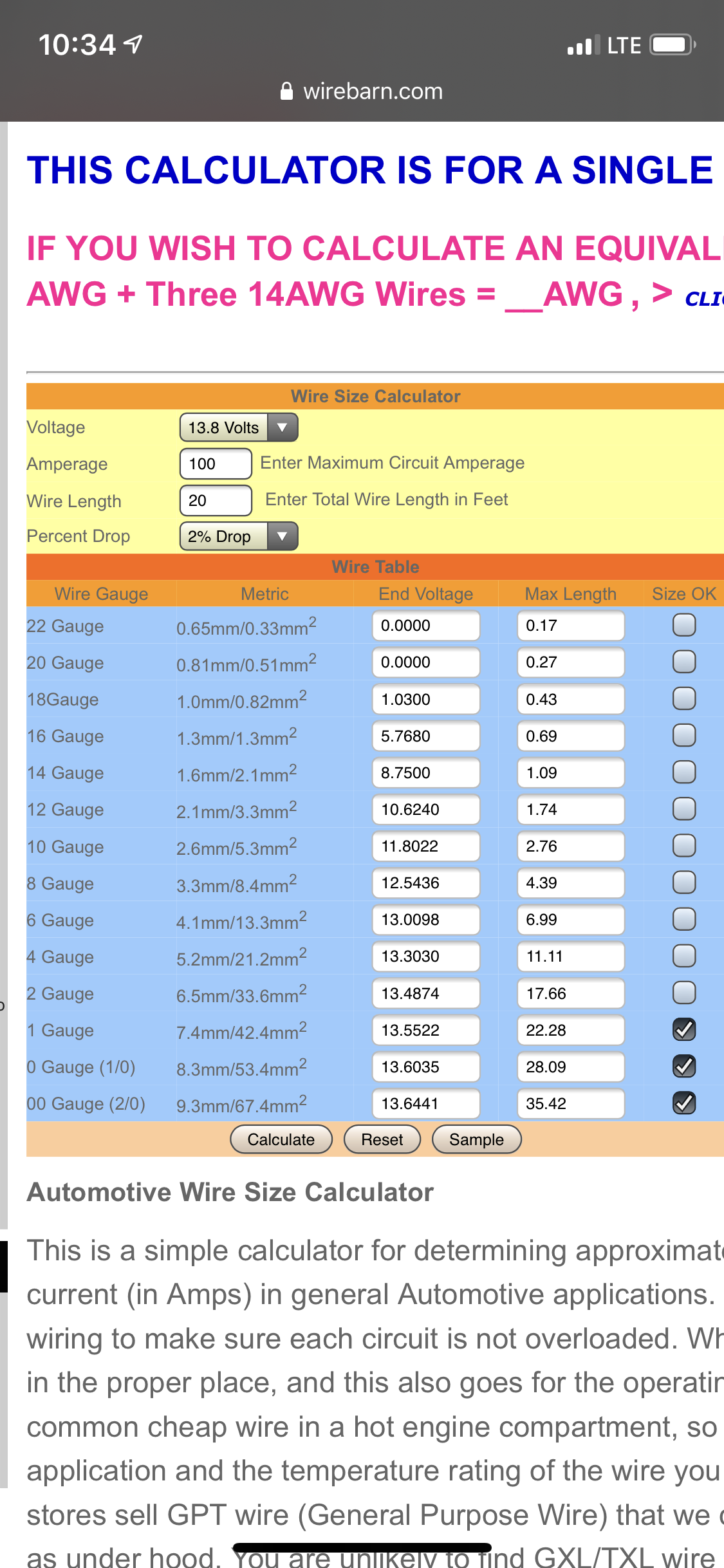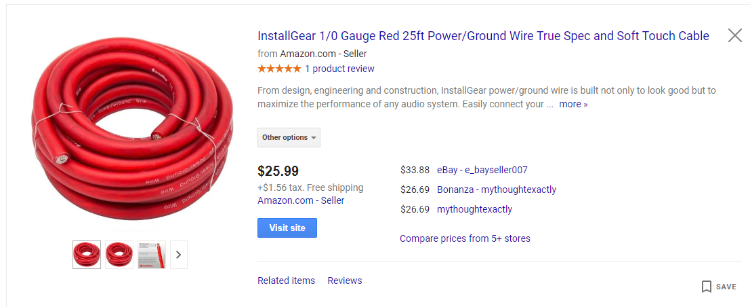Winch Mount Options
|
Administrator
|
I'd be surprised if the winch came with the relay I'm talking about, which parallels the vehicle's battery with the trailer or winch's battery. From the diagram and instructions you posted the relay that came with the winch is the one that is in the "solenoid box". That's just the one the light-duty switches turn off/on to control the winch.
The one I'm talking about connects the two batteries, but only when the vehicle is running. Here's how Cole Hersee's smart battery isolator is to be wired. The main difference in that and the way Ford did it are that Ford triggers the relay with the Accessory or Run power where the CH unit is triggered by the electronics in it to parallel the batteries when the main battery is above 13.2v for two minutes. But both use a continuous-duty relay that is capable of carrying the full current of the alternator. Oh yes, there's another difference between Ford's way and the CH way. With the Ford wiring if you have the truck running and use the winch a bunch it is possible to pull both batteries down to the point where the engine dies for lack of ignition. And then both batteries are so low you can't start the truck again. But the CH system disconnects the two batteries from each other if they get down to 12.7 volts for a minute. That way the engine will still run and charge the main battery and you won't be stuck. Personally, the ~$100 for the CH smart isolator is money well spent for the peace of mind knowing you won't be stuck in the back of beyond because you drained the batteries. And you'll probably pay 1/2 of that just to get a continuous-duty solenoid capable of handling the full output of the truck's alternator. 
Gary, AKA "Gary fellow": Profile
Dad's: '81 F150 Ranger XLT 4x4: Down for restomod: Full-roller "stroked 351M" w/Trick Flow heads & intake, EEC-V SEFI/E4OD/3.50 gears w/Kevlar clutches
|
|
I've never been good with electricity.
Let's take a step back. Should I make sure my alternator is the better 145 amp alternator? Do I HAVE to have dual batteries? Will I really be stressing out the factory trailer harness if I ran the winch off the 7-way plug? If dual batteries is absolutely necessary, I will install it that way. Is there a cheaper Isolator than the cole hersee? It was well over $100 in the link you posted earlier gary....I cant remember exactly how much.
1988 F250 Supercab Longbed 7.3 IDI, C6, 1356, GEARVENDORS, 4.10 Sterling with autolocker
1986 F150 302, C6, 9" 2.75, Wood Flatbed |
|
Administrator
|
I'm very sure you will need a 2nd battery. Look at the info you posted on the winch - #6 wires a max of 6' long to the battery. You can't do that with the battery in the truck unless the winch is on the front of the truck.
And the trailer wiring in a vehicle is not capable of handling the draw that winch will have. No way. As for the alternator, I wouldn't worry about which one you have. With a 2nd battery what you have will work. The isolator isn't a requirement. In fact, if you are going to charge the 2nd battery via the vehicle's existing wiring then the vehicle probably has a relay of some sort built in. So check it out.
Gary, AKA "Gary fellow": Profile
Dad's: '81 F150 Ranger XLT 4x4: Down for restomod: Full-roller "stroked 351M" w/Trick Flow heads & intake, EEC-V SEFI/E4OD/3.50 gears w/Kevlar clutches
|
|
Administrator
|
Ray noticed the lever effect I mentioned... in the winch load limits. 😁
Gary, this is why I said to be sure to oversize the cables to the trailer. Length = more resistance, and more resistance = more heat. It's a vicious cycle. Dual Lead 00 welding cable is pretty flexible. I would never try it with aluminum Service Conductor. But it has to be sized for the 1,000 amps, or whatever the vehicle battery is rated for... If you had a dead short and the winch battery failed, it would be taking everything the truck battery had to offer. (Or the whole thing needs to be fused at the truck battery, before any cable)
Jim,
Lil'Red is a '87 F250 HD, 4.10's, 1356 4x4, Zf-5, 3G, PMGR, Saginaw PS, desmogged with a Holley 80508 and Performer intake. Too much other stuff to mention. |
|
All this is so confusing to me.
 Give me an engine and I can tear it down and put it back together, but give me a winch and all I can do is look at it. Ok, joking aside.... From what I can see online, the factory 7-Pin harness will not charge an auxiliary battery, but it can maintain a charge. That is not good enough. I have to be able to charge it. So, this is what I am thinking....I get a couple of gophers and a squirrel cage, mount it to the trailer and have the gophers charge the battery. Anyone think that is a bad idea? Good, i'll get on it! Okay. So I am thinking I need to mount an isolator under the hood near the factory battery. Then run a good hot wire (what gauge?) all the way from the engine bay to the rear battery. Can I ground the battery to the trailer, or should I ground the battery to the truck frame? So, this Isolator, wired as shown in Gary's diagram, would allow the momentary charging of the auxiliary battery only when needed. Would I still need to utilize the 12vdc lead from the 7-way connector to maintain a charge when the isolator isn't sending charging power to the battery? Or is it okay to leave that 12vdc lead unused? Something like this, which is basically the same as Gary's diagram except it makes more sense to me for some reason (cause I is a stupid): 
1988 F250 Supercab Longbed 7.3 IDI, C6, 1356, GEARVENDORS, 4.10 Sterling with autolocker
1986 F150 302, C6, 9" 2.75, Wood Flatbed |
|
In reply to this post by emunder
pricey and IMHO ugly lol. I have seen some mount a receiver so its under the stock bumper.
1985 F-350 XL | 460 | C6 | "Rufus Maximus"
1986 F-150|Standard Cab|4x2|300Six|C6Transmission w/3.08 rear|Name:TBD 2021 Ranger XLT Super Crew | Cactus Grey | black out package | max tow |
|
Administrator
|
In reply to this post by Ray Cecil
Ray - That diagram is good, except I think that is a diode-type isolator as it doesn’t show a trigger wire that a relay would need. I don’t particularly care for diode isolators. That’s because they have a significant voltage drop across them - up to .7 volt. That means that your vehicle battery can be at 14.4 volts and the trailer battery at 13.7, so it won’t be getting a good charge and it’ll take a lot more time to charge it.
Instead I’d use a continuous-duty relay that can handle the full output of your alternator. And trigger it with a key-on source so the batteries are only paralleled when the key is on - and hopefully the engine is running. And yes, you need a heavy gauge wire to run back to the trailer. And no, you can’t use the 7-pin as it’s terminals can’t handle that much current. And yes, it is ok to leave that terminal unused. As for the wire size as well as the connector to use, I need to do some searching in order to answer those questions. But I’m sitting in Starbucks (Christmas Blend) in Owasso so am on the phone and it isn’t as easy as on the computer. I’ll be back....
Gary, AKA "Gary fellow": Profile
Dad's: '81 F150 Ranger XLT 4x4: Down for restomod: Full-roller "stroked 351M" w/Trick Flow heads & intake, EEC-V SEFI/E4OD/3.50 gears w/Kevlar clutches
|
|
Administrator
|
Wire size. I used the calculator here (https://www.wirebarn.com/Wire-Calculator-_ep_41.html) and arbitrarily chose 20’ and 100 amps and got the results shown below.
The length is assuming you run the ground to the frame of the truck and don’t run a ground wire from the battery, in which case the wire run would be longer. But you will run from the frame, through a new HD connector, and then to the battery. Do not try to use the trailer’s ground in the 7-pin as those terminals cannon handle the current. And the current of 100 amps is just a guess. It is less than the alternator can throw, but you have resistance in the circuit with all the wiring that will limit the current flow. And that says 1 gauge wire will work with a 2% voltage drop. But you could probably get by with 2 gauge. I’d go buy welding cable as Jim suggested. Now to find a connector..... 
Gary, AKA "Gary fellow": Profile
Dad's: '81 F150 Ranger XLT 4x4: Down for restomod: Full-roller "stroked 351M" w/Trick Flow heads & intake, EEC-V SEFI/E4OD/3.50 gears w/Kevlar clutches
|
|
Administrator
|
This is the style of connectors I have on my trailer and on Big Blue: https://www.wiringproducts.com/high-power-connectors. I bought mine at Graybar if I remember correctly and didn’t pay that much. But, these connectors are expensive and you will need two of them as well as the terminals.
I’ll see if I can find the exact ones I bought, but that will have to wait until I get home. You MIGHT get by with the 50 amp ones, but I’d be afraid of them myself. Yes, this is getting expensive, but it is the way to do it.
Gary, AKA "Gary fellow": Profile
Dad's: '81 F150 Ranger XLT 4x4: Down for restomod: Full-roller "stroked 351M" w/Trick Flow heads & intake, EEC-V SEFI/E4OD/3.50 gears w/Kevlar clutches
|
|
In reply to this post by Gary Lewis
Gary, thanks for all the help! So, I think I've got all the information I need now.
There are much cheaper Cole Hersee continuous duty solenoids than the one you posted awhile back. What is the difference between the $125 one and the $20, $30 and $40 ones? 
1988 F250 Supercab Longbed 7.3 IDI, C6, 1356, GEARVENDORS, 4.10 Sterling with autolocker
1986 F150 302, C6, 9" 2.75, Wood Flatbed |
|
Administrator
|
In reply to this post by Gary Lewis
Up here we have upfitters that carry all that stuff for the electric/hydraulic plows they sell and install.
Plugs, sockets, cable... But like I said, oversize it. Cry once and be set for good. You don't want to get a longer trailer with a bigger winch, and have to rewire the whole truck because the circuit is too small
Jim,
Lil'Red is a '87 F250 HD, 4.10's, 1356 4x4, Zf-5, 3G, PMGR, Saginaw PS, desmogged with a Holley 80508 and Performer intake. Too much other stuff to mention. |
|
Administrator
|
In reply to this post by Ray Cecil
There are two differences. The easy one is that some of the cheaper relays aren’t rated at the amount of current you may be pushing. But the bigger difference is what I explained before - the cheaper ones just parallel the batteries when the key is on - assuming that is the way you wire it. But the smart one parallels them when the main battery gets up to 13.2 volts, if I remember correctly, and disconnects them if they get down to 12.7 volts.
And that means that with the cheaper ones you can kill both batteries as well as the engine and be stuck in the back of beyond. But not so with the smart one. So, are you willing to bet that you nor anyone that uses the truck and trailer will do that?
Gary, AKA "Gary fellow": Profile
Dad's: '81 F150 Ranger XLT 4x4: Down for restomod: Full-roller "stroked 351M" w/Trick Flow heads & intake, EEC-V SEFI/E4OD/3.50 gears w/Kevlar clutches
|
|
Administrator
|
In reply to this post by Ray Cecil
Ray,. If you want models and specs go to the Texas Industrial Electric website.
They have a HUGE array of relays, isolators, solenoids, whathaveyou.
Jim,
Lil'Red is a '87 F250 HD, 4.10's, 1356 4x4, Zf-5, 3G, PMGR, Saginaw PS, desmogged with a Holley 80508 and Performer intake. Too much other stuff to mention. |
|
Administrator
|
In reply to this post by ArdWrknTrk
Amen, brother!
Gary, AKA "Gary fellow": Profile
Dad's: '81 F150 Ranger XLT 4x4: Down for restomod: Full-roller "stroked 351M" w/Trick Flow heads & intake, EEC-V SEFI/E4OD/3.50 gears w/Kevlar clutches
|
|
This post was updated on .
In reply to this post by Gary Lewis
Sounds about right Gary, off the top of my head 2 gauge should be good for up to 150amp <10ft of length, at 100amp he should be good under 15ft. After 15ft he needs a bigger hose, I would lean towards 1 gauge or larger. If he is cranking 75 or less 2 gauge should be satisfactory up to about 20-25 feet. Depending on where you go and the style of cable you are probably talking 10-15 or 30-40 cents per foot difference.
1985 F-350 XL | 460 | C6 | "Rufus Maximus"
1986 F-150|Standard Cab|4x2|300Six|C6Transmission w/3.08 rear|Name:TBD 2021 Ranger XLT Super Crew | Cactus Grey | black out package | max tow |
|
In reply to this post by Gary Lewis
Okay. I understand. It will only be me using the winch. And, if I am idling the truck, won't that help it keep up?
Also, I am just making sure I understand the grounding you spoke about. So...I run a 1/0 ground wire from the aux battery to the truck frame?
1988 F250 Supercab Longbed 7.3 IDI, C6, 1356, GEARVENDORS, 4.10 Sterling with autolocker
1986 F150 302, C6, 9" 2.75, Wood Flatbed |
|
Administrator
|
In reply to this post by Danny G
My truck is 18' 8" bumper to bumper, and we know the cable isn't going to be straight.
I'm thinking the trailer battery would probably be in a marine box bolted in the Vee. Then, on to wherever the winch is mounted.
Jim,
Lil'Red is a '87 F250 HD, 4.10's, 1356 4x4, Zf-5, 3G, PMGR, Saginaw PS, desmogged with a Holley 80508 and Performer intake. Too much other stuff to mention. |
Well, I just ordered a 25' 1/0 red cable from amazon. Might not be enough. But I might mount the box in the truck bed. That way I have nothing to lose on the trailer if it gets stolen. The winch will be mounted on the truck anyway.
1988 F250 Supercab Longbed 7.3 IDI, C6, 1356, GEARVENDORS, 4.10 Sterling with autolocker
1986 F150 302, C6, 9" 2.75, Wood Flatbed |
|
Administrator
|
In reply to this post by Ray Cecil
Yes, whatever wire size you run to the battery you’ll also run that size wire from the battery, through the connector, to the truck’s frame.
Gary, AKA "Gary fellow": Profile
Dad's: '81 F150 Ranger XLT 4x4: Down for restomod: Full-roller "stroked 351M" w/Trick Flow heads & intake, EEC-V SEFI/E4OD/3.50 gears w/Kevlar clutches
|
|
Administrator
|
In reply to this post by Ray Cecil
If the battery is in the truck bed you don’t need the connector in that run. But you may want it to the winch so you can permanently connect the winch’s wire to the connector and another connector to the battery.
Gary, AKA "Gary fellow": Profile
Dad's: '81 F150 Ranger XLT 4x4: Down for restomod: Full-roller "stroked 351M" w/Trick Flow heads & intake, EEC-V SEFI/E4OD/3.50 gears w/Kevlar clutches
|
| Edit this page |


